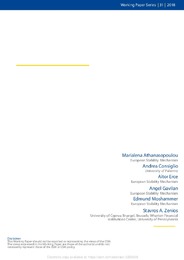| dc.contributor.author | Athanasopoulou, Marialena | en |
| dc.contributor.author | Consiglio, Andrea | en |
| dc.contributor.author | Erce, Aitor | en |
| dc.contributor.author | Gavilan Gonzalez, Angel | en |
| dc.contributor.author | Moshammer, Edmund | en |
| dc.contributor.author | Zenios, Stavros A. | en |
| dc.creator | Athanasopoulou, Marialena | en |
| dc.creator | Consiglio, Andrea | en |
| dc.creator | Erce, Aitor | en |
| dc.creator | Gavilan Gonzalez, Angel | en |
| dc.creator | Moshammer, Edmund | en |
| dc.creator | Zenios, Stavros A. | en |
| dc.date.accessioned | 2019-04-18T10:42:13Z | |
| dc.date.available | 2019-04-18T10:42:13Z | |
| dc.date.issued | 2018-09 | |
| dc.identifier.isbn | 978-92-95085-53-4 | |
| dc.identifier.issn | 2443-5503 | |
| dc.identifier.uri | http://gnosis.library.ucy.ac.cy/handle/7/46098 | en |
| dc.description.abstract | The mix of instruments used to finance a sovereign is a key determinant of debt sustainability through its effect on funding costs and risks. We extend standard debt sustainability analysis to incorporate debt-financing decisions in the presence of macroeconomic, financial, and fiscal risks. We optimize the maturity of debt instruments to trade off borrowing costs with refinancing risk. Risk is quantified with a coherent measure of tail risk of financing needs, conditional Flow-at-Risk. A constraint on the pace of reduction of debt stocks is also imposed, and we model the effect of debt stocks on the yield curve through endogenous risk and term premia.
On a simulated economy, we show that the cost-risk and flow-stock trade-offs embedded in issuance decisions are key determinants of the evolution of debt dynamics and are economically significant. Comparing three alternative optimizing strategies and some simple fixed-issuance rules, we also draw lessons on when and why optimizing matters the most. This depends on the risk tolerance level, the size, cost, and maturity of legacy debt, and the sensitivity of interest rates to debt.
Our model quantifies thresholds for the minimum level of refinancing risks and the maximum pace of debt reduction that a sovereign could reach given its economic fundamentals. Going beyond those thresholds is only feasible through adjustments of gross financing needs, and an extension of the baseline model identifies the hot spots for these adjustments, computing their minimum size and optimal timing. Our findings inform policy decisions concerning both official sector borrowing and public finance, with a focus not only on minimizing interest payments but also on managing refinancing risks and increasing debt dynamics. | en |
| dc.format.extent | 45 | |
| dc.language.iso | eng | en |
| dc.publisher | European Stability Mechanism Working Paper No. 31 | en |
| dc.relation | info:eu-repo/grantAgreement/EC/H2020/655092/DebtRisks | |
| dc.rights | Attribution-NonCommercial-NoDerivs 3.0 Greece | * |
| dc.rights | info:eu-repo/semantics/openAccess | en |
| dc.rights | Open Access | en |
| dc.rights.uri | http://creativecommons.org/licenses/by-nc-nd/3.0/gr/ | * |
| dc.source.uri | https://ssrn.com/abstract=3250806 | |
| dc.subject | Sovereign debt | en |
| dc.subject | Sustainability | en |
| dc.subject | Debt financing | en |
| dc.subject | Optimization | en |
| dc.subject | Stochastic programming | en |
| dc.subject | Scenario analysis | en |
| dc.subject | Conditional Value-at-Risk | en |
| dc.subject | Risk measures | en |
| dc.title | Risk management for sovereign financing within a debt sustainability framework | en |
| dc.type | info:eu-repo/semantics/workingPaper | |
| dc.identifier.doi | 10.2139/ssrn.3250806 | |
| dc.author.faculty | Σχολή Οικονομικών Επιστημών και Διοίκησης / Faculty of Economics and Management | |
| dc.author.department | Τμήμα Λογιστικής και Χρηματοοικονομικής / Department of Accounting and Finance | |
| dc.type.uhtype | Working Paper | en |
| dc.source.other | SSRN | en |
| dc.contributor.orcid | Zenios, Stavros A. [0000-0001-7576-4898] | |
| dc.contributor.orcid | Consiglio, Andrea [0000-0003-1654-9172] | |
| dc.gnosis.orcid | 0000-0001-7576-4898 | |
| dc.gnosis.orcid | 0000-0003-1654-9172 | |


